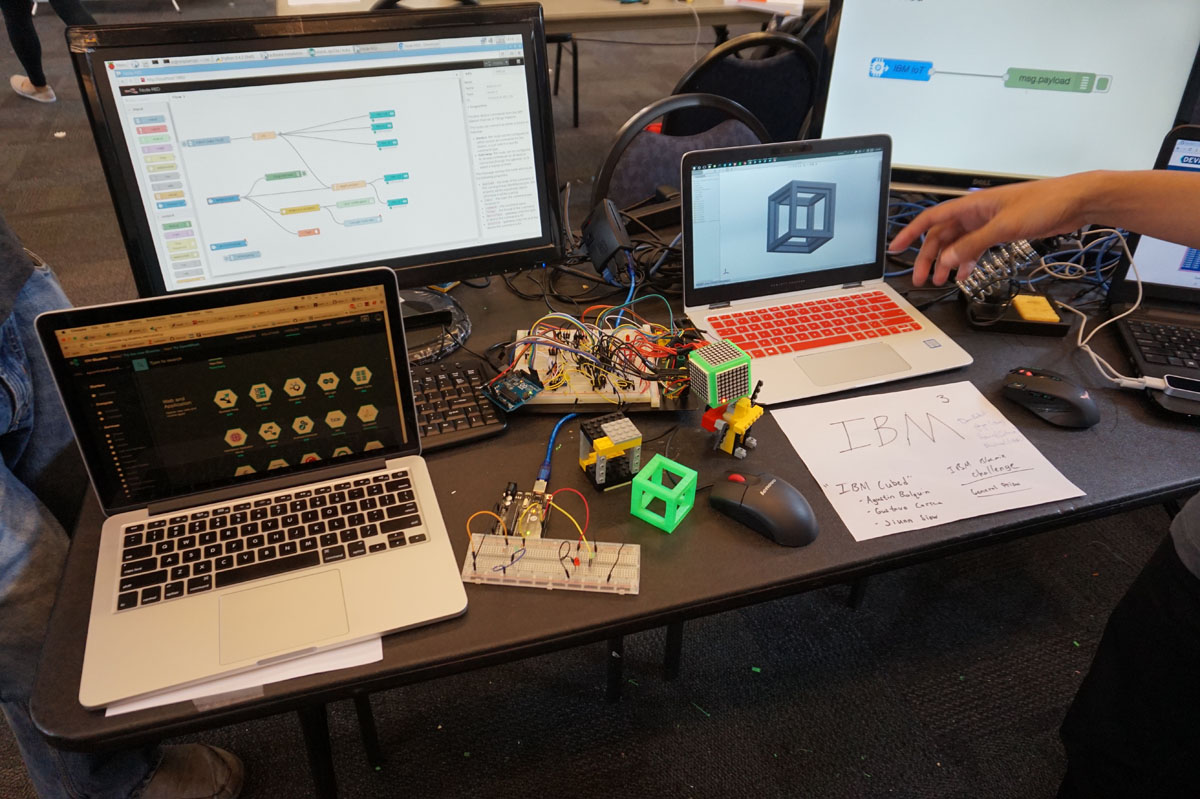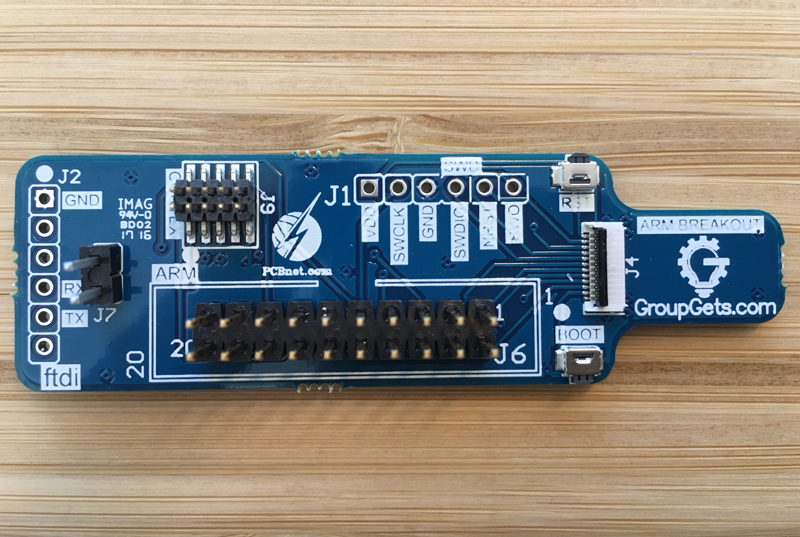The SBHacks event was a huge success. We met amazing makers and hackers from all over California with immense drive and determination, it was an inspiring event. Big thanks to Benji and Major League Hacks for organizing a fun and well-organized event. The surprise keynote by Jay Freeman, aka Saurik, was a nice touch and a perfect way to kick off a hackathon.

GroupGets joined forces with FLIR Systems to create a dynamic duo of thermal infusion. Next to a stockpile of FLIR Ones for iOS and Android, our PureThermal 1 FLIR Lepton Smart I/O Module (PT1) was also featured on FLIR's display booth for testing, demo's, and checkout for the challenges. We have to sincerely thank the FLIR team for inviting us to participate with them and for their energy and dedication - they staffed the event 24-7, gave great tech talks, and responded instantly to hackers in need at all hours of the night.
Also, HUGE shout out to Imagineering Inc for making and shipping our ARM Breakout boards in a ridiculously short amount of time so they would be on-hand for the event.


We had three teams who took our PureThermal 1 Wi-Fi Challenge (described below). The GroupGets team was on hand to coach and mentor hackers during the 36+ hour hackathon.

Unfortunately, no one successfully completed the Wi-Fi challenge but one team got really close and they plan to keep hacking on it. We did award one team with our Wildcard $500 prize.

This team made up of mostly Stanford students used the PT1, in addition to FLIR One, for a medical app that tracks the peak fertility cycles in women via non-contact temperature measurements of the abdomen. They called it Onu Ova. We were intrigued by the scope of their project - there was an iOS app, a cloud-based Wolfram Research computation script, a Linux app controlling the PT1 to take still images and crunch data, and a cloud-based database. The PT1 was used to augment the FLIR One's data and intends to be used in cases where a FLIR One and or appropriate smartphone would not be available. They also plan to keep hacking on the PT1 back at Stanford so we can't wait to see more from them.

Since all of our challengers worked so hard with no sleep and want to continue working on our initial challenge, we gifted them our PT1 board, a FLIR lepton, our new custom ARM JTAG adapter, and an STLink/v2 for debug and flashing.

All in all, it was another beautiful weekend in Santa Barbara.


Original SBHacks Challenge
Accept the PT1 Wi-Fi Challenge at SBHacks!
Calling all SBHackers, GroupGets is looking for an ACE team to do us the honors in making our PureThermal 1 FLIR Lepton Smart I/O Module a truly unique IoT device by adding Wi-Fi command, control, and thermal video transmission. The PT1 can be found on robots, UAV's, and inside medical research facilities throughout the world. Users love it's plug-and-play nature to get thermal video since it is literally a simple USB thermal webcam.

PT1 can currently be controlled and output thermal video over USB but we think it's time to for it to go wireless. For this challenge we'd like to see thermal images from PT1 be received wirelessly on a computer or smartphone either in a browser or another application. We are giving SBHacks contestants that honor and a chance to become real Hack-a-thon heroes. Plus, our users will love you for it and your work will go to use in the real world.
This challenge is for developers who like to get their hands dirty with hardware and develop closer to the metal. Think you have what it takes? Knowledge of C and embedded systems concepts is highly recommended before taking this on.
The FLIR Lepton is the same sensor that is inside of the FLIR One. If you are interested in thermal imaging but prefer to see it in action at a lower level than the FLIR One, then you are in the right place. To stay connected with us and other participants, we've established a chat room via HipChat which you can simply access with this link: N/A. Feel free to ask us questions or share information there.
The Wi-Fi module to be used is the popular ESP8266. It's small, cheap, widely available, and easy to hack! It can can be controlled either with AT commands using its stock firmware or for a deeper level of control, you can install your own custom firmware on it. Don't worry, we've documented how to do that.

We will be supplying all of the necessary hardware to achieve this mission and awarding a $1000 cash prize to the best implementation. The criteria for judging will be...
- The quality of the wireless thermal image received in a browser or applicaiton on a computer and or smartphone
- How many clever convenience features are added such as automated notifications on scene changes in the field of view of the Lepton
- How reliable it is – does not crash often
- How elegant the code is – loosely coupled, readable, efficient, commented,
maintainable - Use of open standards such as MQTT/MQTT-SN but we get it, a weekend is a short amount of time so don't sweat this part too much.
We will also award $500 to a "wild-card" application that is creative but not necessarily Wi-Fi related. The criteria for judging this prize will be...
- Marketability - Is the application one that users will want and does not already exist?
- Creativity - Does the application accomplish something in a unique and special way? Will it create some buzz for PT1?
To be successful you will have to learn about PT1 and the best place to start is our GroupGets PT1 landing page which has links to the hardware schematic and the github code repo. Also check out some of the videos on that site to see it in action on a UAV and even an Android Smartphone to get inspired. Note that you will be given a PT1 with a working application (from our Github) pre-installed so you can see for yourself what the video looks like on your machine of choice (Mac, Linux, and even Windows).
From there dive into our open source firmware implementation on our PT1 github repo that has the command and control of the Lepton completed already for USB video output. You can repurpose that for the Wi-Fi implementation. Start with our Github Wiki.
Next, get up to speed with the Wi-Fi module at the ESP8266 Wiki. There are a ton of other resources from Sparkfun and Adafruit as well from a simple Google search.
To reprogram the PT1 you will need to use the adapter shown below and an ST-Link/v2. Do not use the USB DFU reprogram option. We will be providing the hardware and these software setup instructions. A different adapter will be needed to reprogram the ESP8266 and we will be providing that as well in addition to this software setup guide for building custom ESP8266 firmware.
We will be posting updates to the chat room and this blog throughout the event so stay tuned. Also, please follow us on twitter or Facebook to get updates on group buys for exclusive parts and modules for your projects.
The SBHacks Hackathon event is taking place from April 22 - 24 at the UCSB campus in Santa Barbara. It's free and open to everyone! More details are available at SBhacks.com.
Happy hacking!








